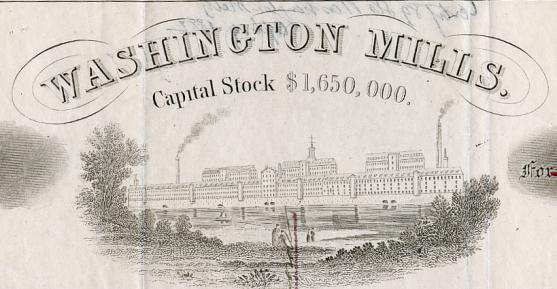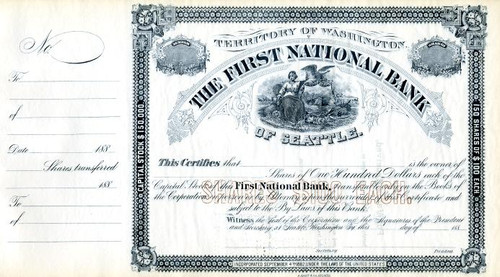Beautiful certificate from the Washington Mills Company issued in 1882. This historic document has an ornate border around it with a vignette of an the company's plant. This item has the signatures of the Company's President and Secretary and is over 124 years old. 
Certificate Vignette History of Lawrence Massachusetts as reported in 1890 LAWRENCE is one of our splendid industrial cities, which has sprung up, as if by magic, at the bidding of the mechanical, the liberal and enterprising spirit of the State. It is situated in the northwestern part of Essex County, on the Merrimack River, 26 miles from its mouth, eight miles above Haverhill, nine below Lowell, and 26 miles north of Boston. Methuen lies on the north and west, Andover on the south and west, and North Andover on the east. It embraces an area of about a square mile and a half, -- 2,173 acres being on the north side, and 2,012 on the south side of the Merrimack River.* The Shawsheen enters the Merrimack at the eastern line of the town, having formed half the divisional line between the city and North Andover, which is completed from this point by the larger river. The Spicket River crosses the northern portion of the city, entering the Merrimack within the limits, and just after receiving the waters of the northern canal. The tide flows up the Merrimack to Mitchell's Falls, some three miles below the city. Shortly previous to 1880, the United States government so improved these falls that coal barges of 4 feet draft, and small, flat-bottomed steam-boats, can come up to the lower part of the city. Lawrence is touched by the Boston and Maine Railroad, by its Lowell and Eastern divisions, and by Manchester and Lawrence Railroad, -- giving connections on every side. More than two thirds of the area of the city is a level plain about 60 feet above the sea, with three large hills and several small ones rising from it. The greatest elevation is 245 feet, and the least 25 feet; the highest parts being the eastern and western sections. The soil of the plains is sandy and unproductive, while the hilly portions are clayey and gravelly, and more fertile. The underlying rock is gneissic in some parts, in others argillaceous slate. There are but 36 farms; and their annual product, reported in 1855, was valued at $58,447; this including the greenhouse product of $11,721. The Essex Company, the proprietor of the water-power and surrounding lands, at the very start laid out the streets, and gave lands for a public park and a common, and for the erection of public buildings. The common comprises about 17 acres in the heart of the city, and has a pretty pond in its centre, and is finely ornamented with shade-trees; and the park, on Prospect Hull, is a delightful retreat for rest and recreation. Union and Storrow parks, also, are now attractive spots in the midst of the city. Along the oldest streets, also, are well-grown trees, set when manufacturing began. The aggregate length of the streets is upwards of 80 miles. The dam across the Merrimack, which is the source of the water-power of the city, was commenced in 1845 and completed in 1847. It is of granite, bedded into the rock bottom in hydraulic cement. Its length is l,629 feet, width 35 feet at its base and 12½ feet at the top. It is backed by a layer of gravel to within a few feet of the surface. The cost complete was $250,000. The fall of water is 26 feet. The north canal, completed about the same time, is a little over a mile long, 100 feet wide at the upper, and 60 feet at the lower end and 12 feet deep. It is parallel with the river at a distance of 400 feet. In the space thus enclosed stand most of the large factories using water-power. The second canal, on the south side of the river, was begun in 1870, is 1¼ miles long, and discharges into Shawsheen River. The limit of the water-power of this city is estimated at 10,000 horse-power, of which 7,200 have been sold. The manufacture of cotton cloths in all their variety is the leading industry here; while the manufacture of woollens is very extensive. The city is noted also for its excellence in the manufacture of carpetings. other goods made are steam engines and boilers, mill machinery and mechanical implements, coaches, sewing-machines, hats, clothing, tin-ware, belting, boxes and many others. The five paper mills here employ nearly 400 persons. The principal factories are the Washington Mills and the Atlantic Mills, built in 1846; the Pacific Mills and the Pemberton Mills, incorporated in 1852; the Lawrence Duck Company, incorporated in 1859; the Everett Mills, in 1860; the Lawrence Woollen Company, in 1864; the Arlington Mills, in 1865; the Wright Manufacturing Company, in 1873; the Russell Paper Company; the Lawrence Lumber Company; and the Lawrence File and Spindle Works. Altogether, there are more than 40 corporations in the city; and the plant is valued at more than $13,000,000. The Pacific Mills is probably the largest manufacturing concern in the world; its capital being $2,500,000, while it furnishes employment to about 3,500 persons. The value of all the goods made in the last census year (1885) is given at $18,257,822. The number of dwelling-houses assessed is 5,676. The valuation of the city in 1888 was $28,971,979, with a tax-rate of $16 on $1,000. There are five national banks, with an aggregate, capital of $1,025,000; and three savings banks, now carrying deposits to the amount of about $7,000,000. The population in 1880 was 39,151; in 1885 it was 38,862, -- a falling off owing to the suspension of work in some of the mills. The loss was transient; the population hoeing estimated in January, 1889, as about 45,000. The water-works furnish an ample supply of water, and the drainage is thorough. The public schools embrace four grades, from primary to high, and occupy buildings valued in 1885 at $334,050. Beside the public schools, there is a German school, the Lawrence Private School, and that of St. Mary's School Society. The Lawrence Free Public library has over 31,000 volumes; and the Pacific Mills Library has upwards of 6,000. The leading periodicals of Lawrence are the "American," the "Eagle" and the "Morning Times," -- dailies; and the "American" and "Andover Advertiser," "Essex Eagle," "Sunday Spice," "Sunday Telegram," "Anzeiger," and the "Journal" (German), and the "Sentinel," -- weeklies. The churches are divided among the denominations as follows : Baptist, 2; Congregationalist, 5; Free Baptist, 1; Methodist Episcopal, 4; Presbyterian, 1; American Episcopal church, 3; Roman Catholic, 5; and the Second Advent, Unitarian and Universalist, each 1. The principal charitable institutions are the Free General Hospital, the Orphan Asylum, Day Nursery for Infants, City Mission, Young Men's Christian Association, Mutual Friend Society for Young Women, the White Free Lectures and Library Fund, Industrial School and Reformatory for Boys. There are the usual societies and social organizations, two ample theatres and several halls. Lawrence is one of the three court-towns of Essex County, and has a courthouse and a registry of deeds for the northern district of Essex County. Previous to 1835, Daniel Saunders, of Andover, a woollen manufacturer, made examinations regarding the rapids of the Merrimack between Methuen and Andover, known as Deer's Jump and Peter's and Bordevell's falls; and in 1843 he quietly made purchases of adjacent lands. The next year he became associated with William, Samuel and Abbott Lawrence; when they employed George Baldwin, noted as a civil engineer, to make a survey of the river below Lowell; and on the completion of his work they began, as the "Merrimack Water-power Association," to openly purchase land, until they had secured both sides of the river, including the flowage, as far back as Lowell, amounting to between 3,000 and 4,000 acres. Associating with themselves Nathan Appleton and others, they obtained from the legislature the next winter a charter for the Essex Company, for the purpose of building a dam and developing the water-power. The company organized in April, choosing Abbott Lawrence as president. Charles S. Storrow was appointed engineer; and the work commenced at once. On March 20, 1845 (the same date as the charter of the Essex Company), an act was passed by the General Court setting off parts of Andover and Methuen about the falls, and incorporating these as the town of Lawrence. This act appears not to have gone into force until April 19, 1847. Along the line of the river at this time were two or three rude fish-wharves, the locality being noted for eel and salmon fishing. The houses were few indeed, and the total number of inhabitants within the limits, at the first date, was not over 200. On March 21, 1853, Lawrence was incorporated as a city; and two years later its inhabitants numbered 16,000. South Lawrence is connected with the north section by steam and street railroads and is rapidly increasing; having its churches, railroad station, large grain mill, and several manufactories, the power being supplied by water drawn from the Merrimack and discharged into the Shawsheen River. The other villages are Chapinsville, Hallsville, North Lawrence, South Lawrence and Arlington District. Lawrence has had two disastrous fires; one, on August 16, 1859, when a hotel, a church, the courthouse, and several stores were destroyed, and two firemen perished; the other, on January 10, 1860, when the Pemberton Mill, a building five storks high, fell without a moment's warning, and the ruins instantly took fire, There were 700 persons in the mill when the crash came, and of these, 100 lost their lives, 14 being known to have perished by the flames. The architecture of this mill was very defective; but the fine new structure which has arisen on its ruins is very strongly built. History from pp. 403-406 in Nason and Varney's Massachusetts Gazetteer, 1890

Certificate Vignette














